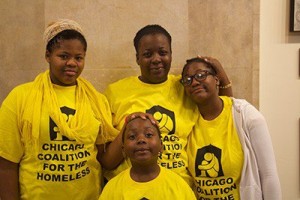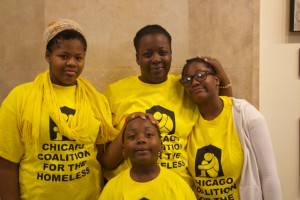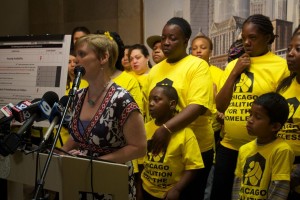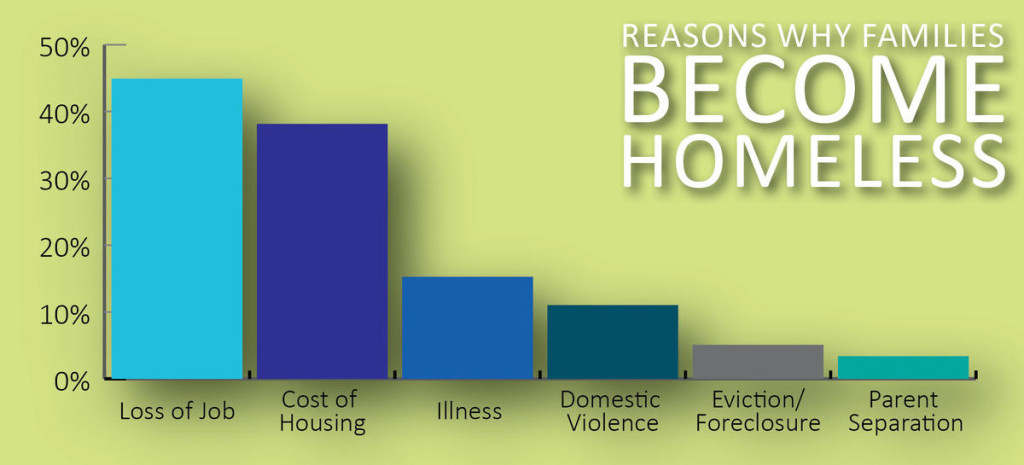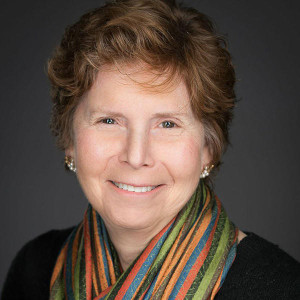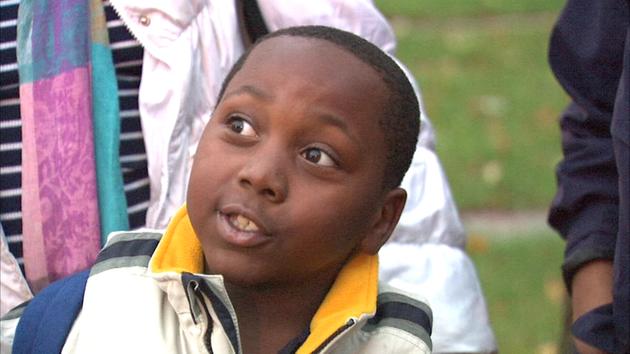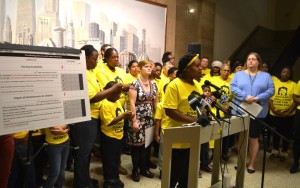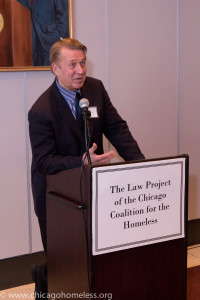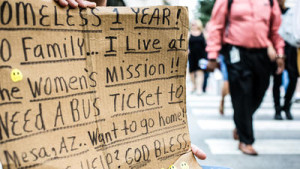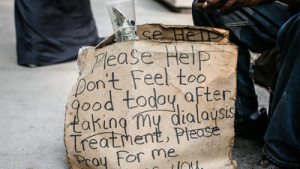
While on parole, John Hilton, 46, stays at St. Leonard’s Ministries on the West Side. The organization works to rebuild the lives of men and women recently released from prison. Lou Foglia / Sun-Times
While on parole, John Hilton, 46, stays at St. Leonard’s Ministries on the West Side. The organization works to rebuild the lives of men and women recently released from prison.
Back when he was a student at Orr High School in West Humboldt Park in the 1980s, John Hilton says he was on the baseball team and played French horn in the marching band.
But to fit in, he says he also started drinking and doing drugs — marijuana, cocaine, eventually heroin.
He’d once hoped to go on to play in a college marching band. By his early 20s, though, he says he was dealing crack cocaine to support his own habit.
“I sold to use, and I used to sell,” Hilton says.
In 1992, Hilton was busted by an undercover cop while working in a crack market. After a year in prison, he returned home to the West Side promising himself he’d never go back.
But Hilton says he couldn’t find legal work and ended up working the drug market at West End and Pulaski again.
“The same guys who was dealing with me before I got locked up greeted me with open arms,” he says.
Hilton, now 46, spent the next 23 years in and out of prison on drug and gun charges.
Out since June, he’s among a growing number of ex-cons being released on parole in Illinois and trying to leave prison behind for good. In the past four years, the number of parolees in Illinois has shot up by 14 percent, to more than 28,000, according to the Illinois Department of Corrections.
They live in communities across Illinois. (Click here to see the number of parolees by Zip code.)
But the largest cluster by far — one of every six parolees — is, like Hilton, on the West Side, straining an area already struggling with crime and joblessness.
“They come in to my office every day looking for help,” says Ald. Walter Burnett Jr. (27th). “But there’s really not enough resources.”
And the numbers are projected to keep growing. How the state responds could have implications for preventing crime and creating jobs far beyond the West Side.
In February, Illinois became part of a national movement to reduce the number of people in prison, with Gov. Bruce Rauner setting a goal of cutting the state’s inmate population by one-fourth in the next decade.
“By reforming our criminal justice system, we can make our prisons safer, rehabilitate ex-offenders so they become productive members of society and save many tens of millions of dollars,” he said in his budget address.
The governor said that could work only if the state can keep ex-offenders from going back to prison. Within three years of their release, 48 percent of all former inmates in Illinois end up in prison again, according to state officials.
To reduce that number, those on parole need stable housing and jobs, both of which already are in short supply in many areas, according to experts, advocates and parolees like Hilton.
When prisoners are paroled, they have to give state officials the address where they’ll be living. That’s usually their family’s home but sometimes a friend’s, a transitional facility, even a homeless shelter. They’re given a bus ticket home and assigned a parole officer.
“People are overwhelmingly positive about how easy it’s going to be to stay out ‘this time,’ ” says Jocelyn Fontaine, who has studied ex-offender programs on the West Side as a senior research associate with the Urban Institute, a think tank. “But the neighborhoods where re-entry is concentrated are the places where crime is concentrated. And those are the most disadvantaged neighborhoods in the country. There’s not a lot of stuff — and they need a lot of stuff.”
Food, for one thing. And clothing. Then, there are costlier expenses such as substance-abuse treatment and job-training.
When they’re provided those kinds of services, things tend to go better, Fontaine says. It’s easier to stay upbeat — and out of trouble.
But she says, “When the doors are closing on you — you can’t find a job, you’re back in the same neighborhood, you see your old life, and you see no alternatives — you can fall back on the one you know.”
John Hilton agrees. During his most-recent prison term — doing time at the downstate Sheridan Correctional Center for dealing heroin — Hilton went through substance-abuse treatment for the first time. He says he realized he was tired of “doing the same things” and asked to be sent to a transitional center that could offer him housing and work when he got out.
Hilton ended up at St. Leonard’s Ministries, an agency on the West Side. He says he’s taken anger-management classes there, learned computer and job-interviewing skills and volunteered for the Chicago Coalition for the Homeless. He’s working for the CTA through a program for ex-offenders, he says, and has enrolled at Harold Washington College starting next semester. His goal: to be a substance-abuse counselor.
“My main objective was to try something different besides going home,” Hilton says of asking for help. “It was the best decision I made in my life.”
The demand for programs like the one at St. Leonard’s has been growing for decades. Illinois’ prison population, following a national trend, more than quadrupled between 1978 and 2011, driven mostly by drug offenses and other non-violent crimes. Programs to help people getting out of prison haven’t kept pace.
Over the past four years, the prison population has inched down from about 49,000 in 2011 to 47,000 this fall, according to state figures. The facilities are designed to hold just 32,000 inmates, though.
Meanwhile, the number of inmates released on parole is up from 24,809 in 2011 to 28,319 this summer.
The West Side accounts for just 3 percent of the state population — but it’s home to 17 percent of the state’s parolees. In Garfield Park and Austin, about one of every 50 residents is on parole.
Altogether, there are nearly 12,000 people on parole across Chicago. That’s in addition to thousands of other former inmates.
Burnett says most who come to his office are looking for work — and most of those job-seekers are ex-offenders.
Burnett himself did time for armed robbery in the early 1980s before receiving a full pardon. He says he tries to help out with job leads, referrals to service organizations and sometimes a bus pass or money for a union card.
“You want them to stay being an ‘ex-offender,’ ” he says.
Some business owners make a point of hiring former prisoners. Charmaine Rickette, CEO of the West Side-based Uncle Remus Saucy Fried Chicken franchise, says she’s developed a hiring process that includes a drug test, a personality test and conflict-resolution training. More than 75 percent of employees at the company’s four restaurants have a criminal background.
“It’s known that we have a crisis,” Rickette says. “The guys standing on the corner, if they don’t have an example, they don’t know what to become.”
While the number of former prisoners has swelled, state funding to help them slowed to a trickle over the summer, among the victims of the war between Rauner and Democratic legislative leaders over the state budget.
In the 2014 budget year, the Illinois corrections and human services departments spent about $69 million on services to aid people getting out of prison. In the 2015 budget year, they spent $67 million. Since the current, 2016 budget year began July 1, the figure has fallen to $418,000.
“We’re basically working as volunteers,” says the Rev. John H. Crawford Jr., president of F.A.I.T.H. Inc., a state-funded agency in Austin that helps parolees and ex-offenders get the state ID they need to find legal employment.
F.A.I.T.H. is fighting to keep its lights on, Crawford says, even as the number of people seeking its help keeps growing.
“They’re still coming,” he says. “If you reduce the prison population and they come home, how long do you think we’re going to be able to help them all?”
Walter Boyd, the executive director of St. Leonard’s, says he has made layoffs, “and we’re still not out of the woods.”
About 250 parolees a year live in St. Leonard’s facilities. They get meals and are connected with jobs and counseling. Boyd says about 13 percent of them end up back in prison — far below the statewide figure of 48 percent.
“How can you say you want to help reintegrate people if you’re decimating all the services and agencies necessary for their re-entry?” Boyd says.
http://chicago.suntimes.com/news/7/71/1118385/watchdogs-boom-parolees-hits-chicago



